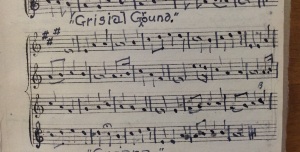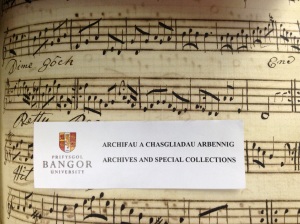
Llun trwy Garedigrwydd Archifau a Chasgliadau Arbennig, Prifysgol Bangor
Photograph courtesy of Archives and Special Collections, Bangor University
~~~~~~~~~~
Dyma ‘Codiad yr Hedydd’, sydd yn alaw o lawysgrif Bangor Ms. 2296 sef Llawysgrif Robert Thomas o Gaernarfon, ar dudalen 12 (gweler mwy o wybodaeth am Robert Thomas a’i lawysgrif yma).
Mae hi’n fersiwn o alaw mwy adnabyddus gan David Owen, ‘Codiad yr Ehedydd’ (gweler fersiwn o honno yma ar wefan MeuCymru). Gosododd Ceiriog eiriau i’r dôn.
Dyma’r geiriau sy’n cael eu canu isod yn yr enghraifft o’r alaw a’i recordiwyd ar gyfer y blog. Roedd offerynwyr a chantorion yn chwarae a chanu’r geiriau a’r alaw yn Arbrawf Mawr trac 2014 ar Ynys Môn. Diolch yn fawr iddyn nhw!
~~~~~~~~~~
This melody is called ‘Codiad yr Hedydd’ which translates to ‘The Rising of the Lark’. This is a melody on page 12 of Bangor Ms. 2296 (Robert Thomas’ manuscript – see more information on Robert Thomas and his manuscript here)
The tune is a version of the a more familiar tune, ‘Codiad yr Hedydd’, by David Owen. (A version of that tune can be seen here on the MeuCymru website). Ceiriog set the words to the tune.
These are the words that are sung in the example of the tune below, which was recorded for the blog. Instrumentalists and singers at trac’s Big Experiment 2014 on Anglesey played the tune and sung the words especially for the blog; a big thank you to them!
~~~~~~~~~~
Ewch yma i weld yr alaw mewn nodiant safonol/Click here to see the tune in standard notation: Codiad yr Hedydd
Dyma nodiant abc o’r alaw/Here’s the melody in abc notation: Codiad yr Hedydd
Dyma offerynwyr a chantorion Arbrawf Mawr trac yn chwarae a chanu’r alaw, os hoffech ei dysgu wrth glust:
Here are instrumentalists and singers in trac’s Big Weekend playing and singing the tune, if you’d like to learn the it by listening:








